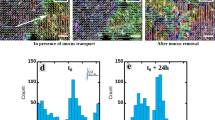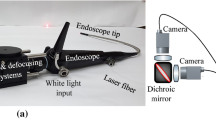Summary
The various principles which have been applied in measuring the ciliary activity may be divided, roughly, into indirect methods in which the rate of the mucous flow is determined and the direct methods in which the number of active ciliary beats per time unit is measured. The three different principles of the direct method are: (1) Stroboscopic, (2) microcinematography, and (3) microphotooscillographic. The latter method, which we have used in studies on ciliary activity in the human respiratory tract, possesses the great advantage of being able to differentiate and measure the activity of the individual cilium, whereas the other two methods often measure the activity of a cluster of cilia. The result is obtainable in the form of a curve showing directly the frequency of the ciliary beats. The biopsies of ciliated epithelium were removed from the posterior part of the nasal cavity, from the larynx, and from the caring.
The microphotooscillographic method is relatively easy to employ as a routine in clinical practice and is applicable for investigating the effect of various drugs upon ciliary function as well as the activity in various disease states.
Zusammenfassung
Die verschiedenen Prinzipien, die bisher bei der Messung der Ciliar-Aktivität angewendet wurden, kann man ungefähr unterteilen in indirekte Methoden, bei denen die Geschwindigkeit des Schleimflusses bestimmt wird, und in direkte Methoden, bei denen die Anzahl der aktiven Cilien-Schläge pro Zeiteinheit gemessen wird. Die 3 verschiedenen Prinzipien der direkten Methode sind: 1. Stroboskopie, 2. Mikrokinematographie und 3. Mikrophotooscillographie. Letztere Methode, welche wir für die Bestimmung der Ciliar-Aktivität im menschlichen Respirationstrakt benutzten, besitzt den großen Vorteil, die Aktivität einer einzigen Cilie zu differenzieren und zu messen, während die anderen beiden Methoden häufig die Aktivität eines ganzen Büschels von Cilien messen. Man erhält das Resultat in Form einer Kurve, die direkt die Frequenz der Cilienschläge zeigt. Die Excisate von Cilien-Epithel wurden vom. hinteren Teil der Nasenhöhle, vom Larynx und aus der Carina gewonnen.
Die mikrophotooscillographische Methode ist relativ leicht als klinische Routinepraxis anwendbar und gestattet die Beobachtung sowohl des Effektes verschiedener Drogen auf die Cilien-Funktion als auch die der Cilien-Aktivität in verschiedenen Stadien von Erkrankungen.
Similar content being viewed by others
References
Ballinger, J. J., Orr, M. F.: Quantitative measurement of human ciliary activity. Ann. Otol. (St. Louis) 72, 31–39 (1963).
Chevance, L. G., Lennon, J. F.: Etude des rythmes du battement ciliaire. Acta otolaryng. (Stockh.) 70, 16–28 (1970).
Dalhamn, T.: Mucous flow and ciliary activity in the trachea of healthy rats and rats exposed to respiratory irritant gases. Acta physiol. stand. 36, Suppl. 123 (1956).
— The determination in vivo of the rate of ciliary beat in the trachea. Acta physiol. stand. 49, 242 (1960).
— Rylander, R.: Frequency of ciliary beat measured with a photo-sensitive cell. Nature (Lond.) 196, 592–593 (1962).
Ewert, G.: On the mucus flow rate in the human nose. Acta oto-Layng. (Stockh.) Suppl. 200, 1 (1965).
Frenckner, P., Richter, N. G.: A method for the study and filming of ciliary activity among animals and human beings. Acta oto-Layng. (Stockh.) 27, 668 (1939).
Gray, J.: The mechanism of ciliary movement. Photographic and stroboscopic analysis of ciliary movement. Proc. roy. Soc. B 107, 313 (1930).
Messerklinger, W.: Über die Sekretströmung auf der Schleimhaut der oberen Luftwege. Z. Laryng. Rhinol. 30, 302 (1951).
— Die Schleimhaut der oberen Luftwege im Blickfeld neuerer Forschung. Arch. Ohr, Nas.- u. Kehlk.-Heilk. 173, 1 (1958).
Proetz, A. W.: Essays on the applied physiology of the nose. 2d ed. Annals publ. Cy., St. Louis 1953.
Purkinje, J. E., Valentin, G.: Entdeckung continuerlischer durch Wimperhaare erzeugter Flimmerbewegungen (1834).
Sharpey, W.: “Cilia” in Todd. Cyclopaedia if anatomy and physiology. Vol. 1, p. 606 (1836).
Yates, A. L.: J. Laryng. 39, 554 (1929).
Author information
Authors and Affiliations
Rights and permissions
About this article
Cite this article
Olsen, P., Westergaard, O. & Balslev Jørgensen, M. Studies on ciliary activity in the upper respiratory tract. Arch. klin. exp. Ohr.-, Nas.- u. Kehlk.Heilk. 201, 241–248 (1972). https://doi.org/10.1007/BF00398007
Received:
Issue Date:
DOI: https://doi.org/10.1007/BF00398007




